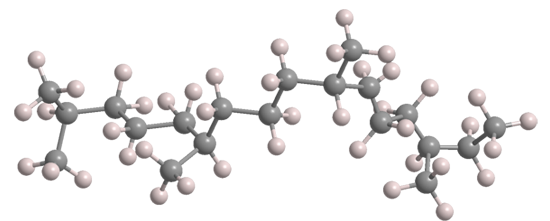What molecule am I?


Phytane is a 20–carbon atom branched-chain alkane. Formally known as 2,6,10,14-tetramethylhexadecane, it has three chiral centers and therefore eight possible stereoisomers. It is normally found as a mixture of most if not all of its isomers.
Unlike lower alkanes that are flammable and present breathing hazards, phytane is essentially nonhazardous. As a chemical, it has no practical uses or commercial value.
Why is phytane a Molecule of the Week? It turns out to be quite useful to geoscientists as a marker of carbon history and, in particular, as a proxy for long-ago carbon dioxide levels in Earth’s atmosphere.
Phytane is a degradation product of chlorophyll, which, of course, is related to CO2 consumption. Jaap Sinninghe Damsté and her co-workers at the Royal Netherlands Institute for Sea Research obtained more than 300 ocean sediments and oils from different locations and geological periods, extracted phytane from them, and determined the 12C/13C ratios in the phytane.
Photosynthesis, and therefore chlorophyll, consumes 12CO2 preferentially to 13CO2. So when the atmosphere is rich in CO2, phytane from chlorophyll has a high 12C/13C ratio. Thus, the researchers could estimate atmospheric CO2 back to the Cambrian period, ≈500 million years ago. Their results matched well with those from existing CO2 proxies that covered shorter time periods.
Chlorophyll is known to have existed as long ago as 1.7 billion years. Geoscientists therefore have the challenge of using proxies to determine atmospheric CO2 levels much farther back than the Cambrian.
Phytane hazard information
| GHS classification*: not a hazardous substance or mixture |
*Globally Harmonized System of Classification and Labeling of Chemicals.
Phytane fast facts
| CAS Reg. No. | 638-36-8 |
| Empirical formula | C20H42 |
| Molar mass | 282.55 g/mol |
| Appearance | Colorless liquid |
| Boiling point | 352–353 ºC |
| Water solubility | 1.7 x 10–5 mg/L |
MOTW Update
Permethrin was the Molecule of the week for September 3, 2002 (no longer online). It is a relatively safe insecticide that, along with other members of the pyrethroid family, is used in “bug bombs” to combat cockroaches. But a recent study at North Carolina State University (Raleigh) showed that bug bombs are completely ineffective for killing roaches. It is believed that over the years, cockroaches have developed resistance to pyrethroids.

Learn more about this molecule from CAS, the most authoritative and comprehensive source for chemical information.
Molecule of the Week needs your suggestions!
If your favorite molecule is not in our archive, please send us a message. The molecule can be notable for its current or historical importance or for any quirky reason. Thank you!
Stay Ahead of the Chemistry Curve
Learn how ACS can help you stay ahead in the world of chemistry.

